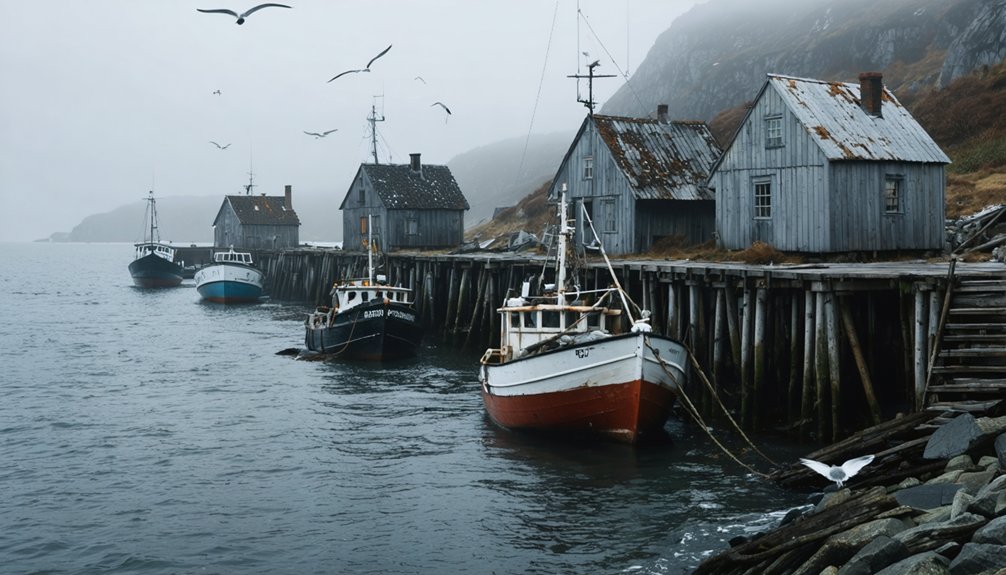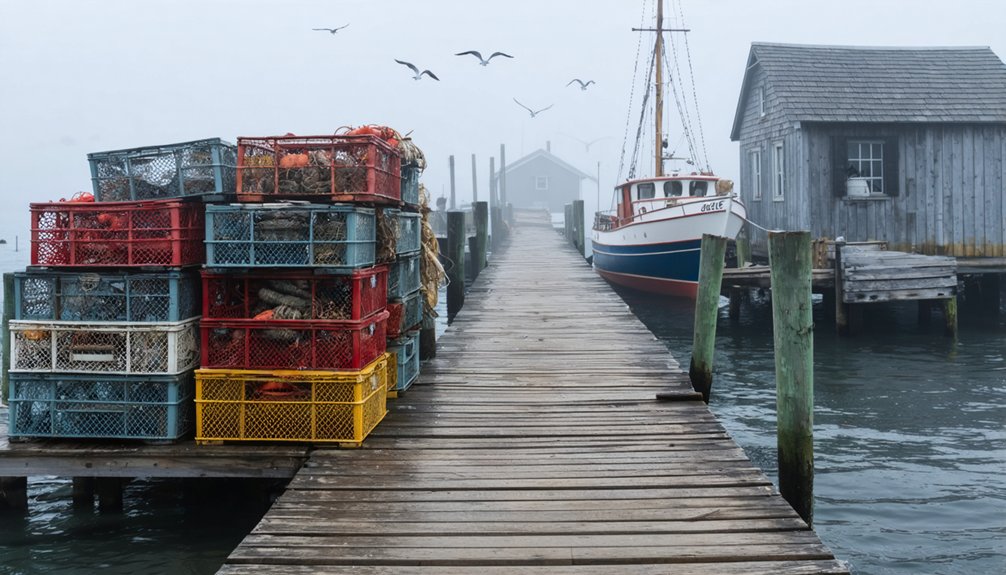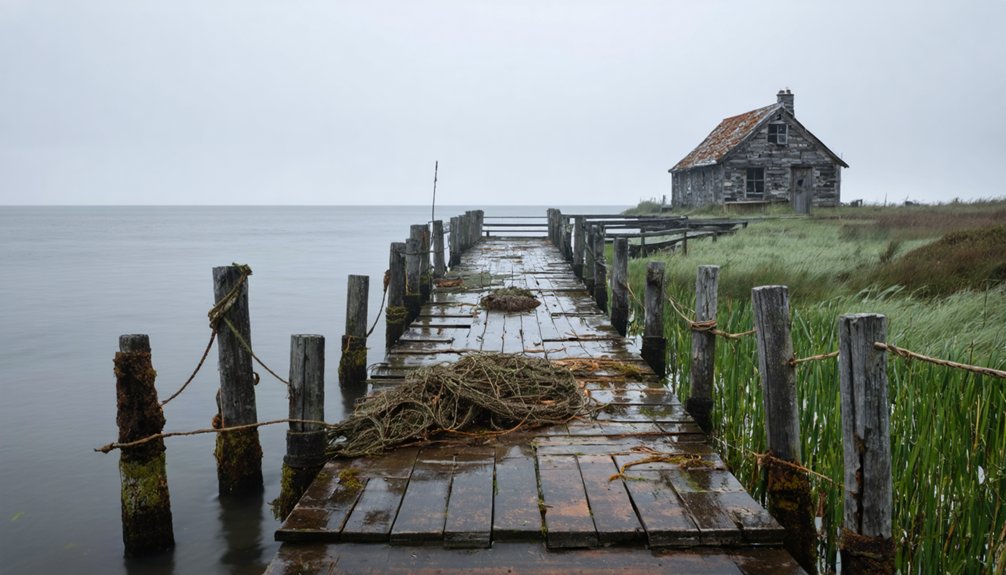Five notable abandoned coastal settlements include Devon’s Hallsands (destroyed by dredging-induced erosion), Japan’s Hashima Island (a concrete mining fortress), Michigan’s Port Oneida (America’s largest rural historic district), Dunwich (England’s medieval port lost to waves), and Cyprus’s Varosha (frozen in time since 1974). You’ll discover how these ghost towns reveal humanity’s complex relationship with the sea through environmental forces, economic shifts, and political conflicts. Each abandoned shoreline tells a tale of maritime rise and fall.
Key Takeaways
- Hallsands in South Devon collapsed in 1917 due to commercial dredging, forcing residents to flee as 37 homes were destroyed.
- Hashima Island near Nagasaki housed 5,000 residents in concrete buildings before being abandoned when coal mining ceased in the 1960s.
- Port Oneida showcases 22 preserved farmsteads within America’s largest National Rural Historic District, abandoned by 1934 as shipping routes changed.
- Dunwich, once England’s tenth largest settlement with 3,000 residents, gradually succumbed to coastal erosion with its last church falling into the sea in 1919.
- Varosha in Cyprus became a ghost town after the 1974 Turkish invasion, preserving a time capsule of belongings from its days as a celebrity resort destination.
Hallsands: The British Village That Slipped Into the Sea
Along the rugged coastline of South Devon, where the English Channel meets the ancient metamorphic rock formations of Start Bay, lies the haunting remnant of what was once Hallsands.
Established in 1784, this fishing village thrived for generations until commercial dredging in the 1890s triggered catastrophic coastal erosion. By removing 660,000 tons of protective shingle, authorities unwittingly condemned the community. The high tide line shifted from 80 feet to merely 3 feet from doorsteps.
Man’s industrial ambitions erased a century of coastal life in mere decades, as the sea reclaimed what was rightfully its own.
You’ll find no trace of the vibrant fishing heritage that sustained 160 souls; their livelihood vanished during the fateful 1917 storm when surging tides devoured 37 homes in a single night. Though all villagers escaped with their lives, their community did not.
Today, Hallsands stands as a stark warning against interfering with nature’s maritime defenses. The village’s location was originally chosen for its safety from piracy and the protection of its secluded position. The government’s inquiry following the disaster never released official reports to the public, further frustrating the displaced villagers who received minimal compensation.
Hashima Island: Japan’s Abandoned Concrete Fortress
Rising from the sea like a forgotten leviathan, Hashima Island stands as a monument to Japan’s industrial ambitions and the impermanence of human settlement.
You’ll find this concrete fortress nine miles from Nagasaki, where Mitsubishi’s coal mining operations once supported over 5,000 residents in one of the world’s most densely populated communities.
As you’d navigate its abandoned corridors, the island’s industrial heritage reveals both innovation and exploitation.
Japan’s first large reinforced concrete building withstood typhoons but couldn’t protect the Korean and Chinese forced laborers who suffered beneath its structures.
When petroleum replaced coal in the 1960s, residents evacuated swiftly, leaving possessions behind.
Today, urban decay consumes this UNESCO World Heritage Site. The island’s apocalyptic atmosphere draws paranormal investigators who report eerie whispers and unexplained footsteps in the abandoned buildings.
Wind-battered apartment blocks and collapsed facilities stand as silent sentinels to humanity’s transience against the relentless sea.
Guided tours now operate on designated walkways, allowing visitors to glimpse this haunting testament to industrial rise and fall.
Port Oneida: Michigan’s Preserved Coastal Community
Unlike Hashima Island’s concrete fortifications, Port Oneida emerges from Michigan’s shoreline as a symbol of rural coastal sustainability rather than industrial exploitation.
While concrete islands celebrate industrial might, Port Oneida honors the delicate balance between human settlement and coastal ecology.
You’ll discover America’s largest National Rural Historic District, where German settlers established a thriving maritime community in 1852, named after the steamship SS Oneida.
This remarkable example of historic preservation showcases the community resilience of settlers who adapted to harsh conditions through diversified livelihoods—farming potatoes in sandy soil while providing cordwood for passing steamships.
Though abandoned by 1934 as shipping routes changed, the 2,000-acre district’s 22 farmsteads, schoolhouses, and barns stand preserved within Sleeping Bear Dunes National Lakeshore.
You can explore these weathered structures via gravel roads and hiking trails, experiencing a maritime landscape largely untouched by modern development. Visitors can access field guides at the Olsen House to enhance their historical exploration. The quick stop at the ranger station is recommended to obtain a Port Oneida booklet with building descriptions and a simple map before beginning your exploration.
Dunwich: England’s Medieval Port Lost to the Waves
While Port Oneida represents preservation triumph against economic decline, England’s Dunwich tells a more somber tale of nature’s relentless power.
Once the tenth largest settlement in England and a premier maritime hub, Dunwich’s impressive coastal fortifications couldn’t withstand the sea’s assault.
You would scarcely believe that this diminutive village was once home to 3,000 souls, with nineteen churches, royal shipyards, and extensive trade networks spanning from Iceland to Spain.
By 1242, Dunwich stood as Suffolk’s largest port, where wealth flowed freely through its sheltered harbor.
The turning point came with catastrophic storms in the late 13th century, particularly in 1287, accelerating coastal erosion that had begun centuries earlier.
These storms were devastating not only to Dunwich but caused an estimated 50,000 deaths in the Netherlands due to flooding.
The historic All Saints Church, a testament to Dunwich’s former glory, was the last major structure to fall into the sea in 1919.
Dunwich’s maritime legacy now rests beneath the waves, a submerged memorial to how quickly the sea can reclaim what man builds.
Varosha: The Mediterranean Ghost Resort Frozen in Time
How can a Mediterranean paradise transform into a ghost town overnight? In 1974, Varosha history changed irreversibly when Turkish forces invaded Cyprus, forcing Greek Cypriot residents to flee their thriving coastal resort.
This once-vibrant destination—where Elizabeth Taylor and Brigitte Bardot vacationed—now stands as a decaying time capsule behind military fences.
For nearly five decades, Varosha tourism has been non-existent, with buildings deteriorating while still containing personal belongings from that fateful day. In 2020, parts of this abandoned area were finally reopened to visitors, though access remains limited due to military presence and strict regulations. Visitors who manage to glimpse the abandoned town often report experiencing paranormal phenomena, including ghostly voices and unexplained shadows moving through empty buildings.
UN resolutions declare only original inhabitants may return, yet political deadlock prevents resolution. The rusting hotels and abandoned shops along pristine beaches create a maritime contradiction—beauty and decay coexisting in haunting harmony.
Despite recent proposals for reopening, this Mediterranean ghost town remains a powerful symbol of how quickly freedom can vanish when geopolitical tides shift.
Frequently Asked Questions
Can Abandoned Coastal Villages Be Safely Repopulated Today?
You can repopulate abandoned coastal villages if you’ve addressed marine resource depletion, structural safety, and legal land rights while building community resilience through sustainable development practices and diversified maritime livelihoods.
How Do Governments Determine When to Evacuate Coastal Communities?
When the writing’s on the wall, governments trigger evacuations based on scientific evacuation criteria: imminent threats, predicted storm surges, clearance times, and community resilience capabilities. You’ll receive mandatory orders when danger is unavoidable.
What Happens to Fishing Rights When Villages Are Abandoned?
When you abandon your village, you’ll typically lose your fishing rights as coastal regulations allow governments to reassign them to active communities, transfer them to commercial entities, or preserve waters for conservation.
Do Former Residents Hold Reunions at Abandoned Fishing Villages?
Like lighthouse beams across time’s foggy sea, you’ll find former villagers gathering in reunion nostalgia at abandoned sites. These exercises in community resilience preserve maritime heritage through annual pilgrimages to their ancestral shores.
How Are Artifacts Protected From Looters in Abandoned Coastal Sites?
You’ll find artifacts protected through legal frameworks, physical barriers, community vigilance, and technological monitoring. These artifact preservation systems create robust looter deterrence networks while maintaining your freedom to appreciate maritime heritage responsibly.
References
- https://en.wikipedia.org/wiki/List_of_ghost_towns_by_country
- https://en.wikipedia.org/wiki/Wikipedia:WikiProject_Ghost_towns
- https://pg.world/articles/abandoned_places_part_1
- https://salford-repository.worktribe.com/OutputFile/3379100
- https://www.nps.gov/slbe/learn/historyculture/ghosttowns.htm
- https://www.countryfile.com/go-outdoors/historic-places/britains-abandoned-coastal-villages
- https://www.loveexploring.com/gallerylist/188219/the-us-state-with-the-most-ghost-towns-revealed
- https://en.wikipedia.org/wiki/Ghost_town
- https://www.amusingplanet.com/2018/07/hallsands-village-that-fell-to-sea.html
- https://www.immortalwordsmith.co.uk/hallsands-abandoned-places/



